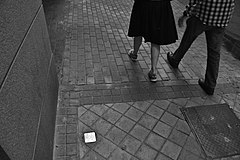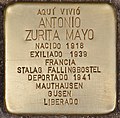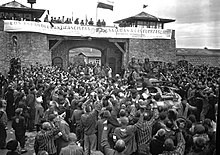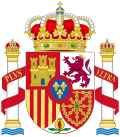List of stumbling blocks in Madrid

The list of stumbling blocks in the Autonomous Community of Madrid contains the stumbling blocks in the Autonomous Community of Madrid in Spain that were laid by the Cologne artist Gunter Demnig . Stumbling blocks remind of the fate of the people who were murdered, deported, expelled or driven to suicide by the National Socialists . As a rule, they are in front of the victim's last self-chosen place of residence.
The first relocations in Madrid took place in the morning of April 26, 2019, in the late afternoon in Moralzarzal . The Castilian translation of the term stumbling blocks is: pedres que fan ensopegar . In Spain, however, they are mostly called piedras de la memoria (memorial stones ).
Fate of the Spanish Republicans
During the German occupation of France , large groups of Spanish republicans who had fled to France after Franco's victory were arrested by the Nazi regime and either handed over to the Vichy regime or deported to the Mauthausen concentration camp . 7,532 Spaniards were imprisoned there and sentenced to forced labor, 4,816, almost two thirds, were murdered by the Nazi regime. The Franco regime stripped the emigrants of their citizenship and made them stateless . In the concentration camp, they had to wear the blue triangle for emigrants and stateless persons. For several decades, the surviving Spanish concentration camp prisoners were denied any form of recognition as victims or any form of reparation.
A total of 9,328 Spaniards were interned in National Socialist concentration camps. Of these, 5,185 died, 3,809 survived. 334 are missing. These numbers include the prisoners from Mauthausen.
On April 26, 2019, the Spanish Council of Ministers, chaired by Pedro Sánchez , decided that May 5 will in future be celebrated as the “day of appreciation for all Spaniards who were deported and killed in Mauthausen and other camps, and for all victims of National Socialism in Spain” .
Stumbling blocks in Madrid
A total of 449 stumbling blocks for victims of the Hitler dictatorship are planned in the Spanish capital Madrid . So far, the following eight stumbling blocks have been laid.
The table is partially sortable; the basic sorting is done alphabetically according to the family name.
| image | inscription | Location | Name, life |
|---|---|---|---|

|
HERE LIVED
JOSE BELLO SÁNCHEZ BORN 1915 EXIL 1939 FRANCE STALAG FALLINGBOSTEL deported 1,940 MAUTHAUSEN FREED |
Calle de Ponzano, 44 |
José Bello Sánchez was born in Madrid on September 9, 1915. In 1939 he went into exile in France. After the occupation of France he was arrested and interned in Stalag XI B in Fallingbostel. On September 8, 1940, he was deported to Mauthausen . There he was given the number 4301. He was used for forced labor in the Gusen satellite camp . Sanchez was liberated on May 5, 1945. |

|
ENRIQUE CALCERRADA
GUIJARRO LIVED HERE BORN 1918 EXILE 1939 FRANCE STALAG TRIER DEPORTED IN 1941 MAUTHAUSEN liberated GUSEN |
Bravo Murillo, 20 |
Enrique Calcerrada Guijarro was born on July 15, 1918 in Madrid. His family came from Puerto Lápice. He spent his childhood there and in Villarta de San Juan. At the age of 18 he volunteered for the people's militias and fought for three years, including in the battle of Guadalajara . In 1939 Guijarro went into exile in France. There he fled the camp in Saint-Cyprien . At the beginning of the Second World War he was working for a French military authority on the Maginot Line . In Saint-Dié-des-Vosges , Guijarro was captured by the German armed forces in 1940 and came to Trier as a prisoner of war . There he was interned in Stalag XII D on Petrisberg . In September 1940 he lost his prisoner of war status. On January 22, 1941, he was deported from Trier to Mauthausen concentration camp , where he was registered with the prisoner number 4,479. A few months after his arrival, he was sent to the Gusen satellite camp. One of the ways he survived was by risking his life stealing potatoes. On May 5, 1945, Guijarro was liberated by US forces and taken to a hospital in Bregenz , where he stayed for almost two years. He was then returned to France. In the reception center he did various jobs, teaching and studying at night. He became a French citizen and initially lived in Paris. He married a Spanish woman with whom he had a son. The couple moved to Bigorre .
He was a member of the FNDIRP (Fédération Nationale des Déportés et Internés, Résistants et Patriotes) and continued to work in the ADIRP (Association des Déportés, Internés, Résistants et Patriotes de Paris) after moving to Bigorre. He helped found the Museum of Deportation and Resistance in Paris. In the 1970s, Guijarro wrote a book that was published in 2003 entitled Republicanos Españoles en Mauthausen-Gusen . It contains a list of 3,820 Spaniards killed in Gusen with name, date of birth, prisoner number and date of death. Enrique Calcerrada Guijarro died on March 16, 2004. |

|
PEDRO DÍAZ
CLEMENTE LIVED HERE BORN 1904 EXILE 1939 FRANCE STALAG FALLINGBOSTEL DEPORTED 1941 MAUTHAUSEN MURDERED December 18, 1941 HARTHEIM |
Calle Virtudes, 22 |
Pedro Díaz Clemente was born on May 19, 1904 in Santa María de Poyos . The family, he had siblings, moved to Madrid, where he worked in various companies. He was married to Mercedes Espinosa Ojeda, with whom he had a daughter.
In 1939 he had to leave the country due to his wife's family environment and went into exile in France without his family. His wife received messages from him from a camp in Le Barcarè . On June 17, 1940, Clemente was captured by National Socialist troops and held with prisoner number 7099 in Frontstalag 140 in Belfort . On January 15, 1941, he was interned in Stalag XI B in Fallingbostel. His prisoner number there was 87079. On January 27, 1941, he was deported to Mauthausen along with 1,506 other Republicans . There he was given the number 5308. On February 17, 1941, he was transferred to the Gusen satellite camp and had to do forced labor. According to a source, he was transferred to the Hartheim killing center on December 5 . There he was gassed on December 18, 1941. His daughter only found out about her father's fate in 2006. |

|
ANDRES FARIÑAS
ADSUAR LIVED HERE BORN 1919 EXILE 1939 FRANCE STALAG FALLINGBOSTEL DEPORTED 1941 MAUTHAUSEN MURDERED 10/17/1941 GUSEN |
Calle de Viriato, 2 |
Andrés Fariñas Adsuar was born on August 16, 1919 in Madrid, the youngest of three sons. He fought in the Spanish Civil War and after the fall of Catalonia in 1939 went into exile in France, where he was interned in a camp. He enlisted in the French Army and was assigned to a Workers Company (CTE) that was relocated to the Maginot Line. After the German occupation of France, Adsuar's unit withdrew to the south. He was arrested and first came to Frontstalag 140 in Belfort, from there he was transferred to Stalag XI B in Fallingbostel. His prisoner number was 87685. On January 24, 1941, he was on a deportation train to Mauthausen , which reached its destination on January 27, 1941. There he was given the number 5152, his job title was electrician. On February 17, 1941, he was transferred to the Gusen satellite camp and had to do forced labor. He died on October 17, 1941, with kidney inflammation and poor circulation as the cause of death . Only after the Transición did his family find out about his fate. |

|
EUFEMIO GARCÍA
GARCÍA LIVED HERE BORN 1891 EXILE 1939 FRANCE DEPORTED 1940 MAUTHAUSEN MURDERED 19.12.1941 HARTHEIM |
Franco Rodríguez, 104 |
Eufemio García García was born on September 17, 1881 in Cañizal , Zamora province . In 1939 Eufemio García García went into exile in France. After the occupation of France, he was interned in the Angoulême camp. On August 20, 1940, he arrived at Mauthausen concentration camp , where he was given the number 3953. Eufemio García García was murdered by gassing on December 19, 1941 in the Hartheim killing center near Linz. |

|
EUSEBIO GONZÁLEZ
MONTEALEGRE LIVED HERE BORN 1914 EXILE 1939 FRANCE STALAG VESOUL DEPORTED IN 1941 MAUTHAUSEN Liberated |
Calle de Pinos Baja, 3 |
Eusebio Gonzáles Montealegre was born in Madrid on June 13, 1913. In 1939 he went into exile in France. After the occupation of France, he was arrested and interned in the Vesoul Frontstalag. On August 8, 1941, he arrived at Mauthausen concentration camp and was given the number 4003. There he was used for forced labor; on May 5, 1945 he was liberated by US troops. |

|
GREGORIO REBOLLO
GARCÍA LIVED HERE BORN 1903 EXILE 1939 FRANCE STALAG STRASBOURG DEPORTED 1940 MAUTHAUSEN MURDERED 29.6.1942 GUSEN |
Nenúfar, 6 |
Gregorio Rebollo García was born in 1903 in Alpedrete , a municipality in the northwest of the Community of Madrid . He took part in the defense of the Second Spanish Republic and fought, among other things, in the Battle of the Ebro . After the defeat of the Republicans, he fled into exile in France. There he fought in the French army. On June 20, 1940, he was captured by the National Socialists in Saint-Dié-des-Vosges in the Vosges and then interned in the Stalag VD in Strasbourg. Gregorio Rebollo García was sent to convoy No. 12 deported to Mauthausen concentration camp , where he arrived on December 13, 1940 and was registered with the number 5176. He was transferred to the Gusen satellite camp, where he was given the number 11877. Gregorio Rebollo García was murdered by the Nazi regime on June 29, 1942. |

|
ANTONIO ZURITA
MAYO LIVED HERE BORN 1918 EXILE 1939 FRANCE STALAG FALLINGBOSTEL DEPORTED 1941 MAUTHAUSEN liberated GUSEN |
Espronceda, 7 |
Antonio Zurita Mayo was born in Madrid on November 20, 1918. In 1939 he went into exile in France. After the occupation of France he was arrested and interned in Stalag XI B in Fallingbostel. On January 27, 1941, he was deported to Mauthausen concentration camp , where he was given the number 6824. He was used for forced labor in the Gusen satellite camp . On May 5, 1945 Antonio Zurita Mayo was liberated.
|
Stumbling blocks in Moralzarzal
A stumbling block has so far been laid in the municipality of Moralzarzal .
| image | inscription | Location | Name, life |
|---|---|---|---|

|
MELCHOR ANTUÑANO
MONTALVO LIVED HERE BORN 1907 EXILE IN 1939 ARRESTED 4.6.1940 INTERNED IN STALAG SAGAN DEPORTED 1941 MAUTHAUSEN MURDERED December 19, 1941 GUSEN |
Plaza de la Constitución 1 |
Melchor Antuñano Montalvo was born on April 25, 1907 in Moralzarzal, the oldest of eight children. His parents were Antolín Antuñano Olazábal and Luisa Montalvo Domínguez. When he was 14 he went to Madrid to work in his uncle's tableware business. On April 21, 1934, he married Valentina Damiana Martín Rodríguez, with whom he had three children. Montalvo joined the police corps before the civil war began. After the outbreak of the Spanish Civil War , he fought on the side of the Republic. In February 1939 he fled to France, where he was in the camp in Le Barcarè , where tens of thousands of refugees were staying in June 1939. At the end of 1939, the Spanish Republican refugees had two options from France: join the Foreign Legion or join a work company in the French army. Montalvo chose the work company. With more than 200 other Spaniards, he was part of the 118th work company. On June 4, 1940, he and 2,000 other Spaniards were captured by German troops at Bray-Dunes . He was interned in Stalag VIII C near Sagan with the number 36283. On June 26, 1940, he sent another letter from here, the last one to his family. In November 1940 he was transferred to Stalag XII-D in Trier. On January 25, 1941, he was transferred to Mauthausen concentration camp , where he was given prisoner number 3241. He was assigned to forced labor in the Gusen satellite camp . Melchor Antuñano Montalvo was murdered in Gusen on December 19, 1942. His family did not receive confirmation of his death until many years later. |
Web links
- Stolpersteine.eu , Demnig's website
Individual evidence
- ^ Rotspanier: Exhibition , accessed on December 28, 2019
- ↑ a b c El Cajon de Grisom: Stolpersteine en Madrid. Una piedra un nombre , accessed April 28, 2019
- ↑ Conmemorativos en Madrid: Adoquín Stolpersteine 006 , May 11, 2019, accessed on December 28, 2019
- ↑ a b La memoire de la deportation , Livre memorial: LES ARRIVÉES DE SEPTEMBRE 1940 À JANVIER 1941 (III.2.) , Accessed on January 18, 2020
- ↑ Conmemorativos en Madrid: Adoquín Stolpersteine 006 , May 11, 2019, accessed on December 28, 2019
- ↑ Ministerio de Cultura y Deporte - Portal de Archivos Españoles: BELLO SÁNCHEZ, José , accessed on January 18, 2020
- ↑ Deportados: Enrique Calcerrada Guijarro , with a photograph provided by his niece Esther Calcerrada, accessed on December 28, 2019
- ↑ Ministerio de Cultura y Deporte - Portal de Archivos Españoles: DÍAZ CLEMENTE, Pedro , accessed on January 19, 2020
- ↑ Deportados: Pedro Díaz Clemente , with a photograph provided by his great-nephew Jorge Díaz, accessed on January 19, 2020
- ↑ Deportados: Andrés Fariñas Adsuar , with a photograph provided by his great-nephew Andrés Fariñas, accessed on January 19, 2020
- ↑ Ministerio de Cultura y Deporte - Portal de Archivos Españoles: FARINAS ADSUAR, Andrés , accessed on January 19, 2020
- ↑ Frankfurter Allgemeine Zeitung : A country struggles with memory , accessed on January 19, 2020
- ↑ Ministerio de Cultura y Deporte - Portal de Archivos Españoles: GARCÍA GARCÍA, Eufemio , accessed on January 19, 2020
- ↑ Conmemorativos en Madrid: Eusebio Gonzales Montealegre , accessed on 28 December 2019
- ↑ Ministerio de Cultura y Deporte - Portal de Archivos Españoles: GONZÁLEZ MONTEALEGRE, Eusebio , accessed on January 20, 2020
- ↑ Radio Madrid: La historia de una negación , with a portrait held by his granddaughter Estrella Zorrilla Rebollo, accessed on December 29, 2019
- ↑ Tulio Riomesta: Los nazis ASESINARON al combatiente antifranquista y REPUBLICANO GREGORIO REBOLLO GARCÍA en el campo de exterminio de Gusen (Austria) en 1942 , July 5, 2018, accessed on January 12, 2020
- ^ Ministerio de Cultura y Deporte - Portal de Archivos Españoles: REBOLLO GARCÍA, Gregorio , accessed on January 20, 2020
- ↑ Somos Chamberí: Las placas que recuerdan a los 450 madrileños víctimas de los campos nazis , with photographs of the relocations, accessed on December 29, 2019
- ↑ Ministerio de Cultura y Deporte - Portal de Archivos Españoles: ZURITA MAYO, Antonio , accessed on January 20, 2020
- ↑ Deportados: Melchor Antuñano Montalvo , with a portrait, accessed on December 28, 2019
- ^ Ministerio de Cultura y Deporte - Portal de Archivos Españoles: ANTUÑANO MONTALVO, Melchor , accessed on January 20, 2020


